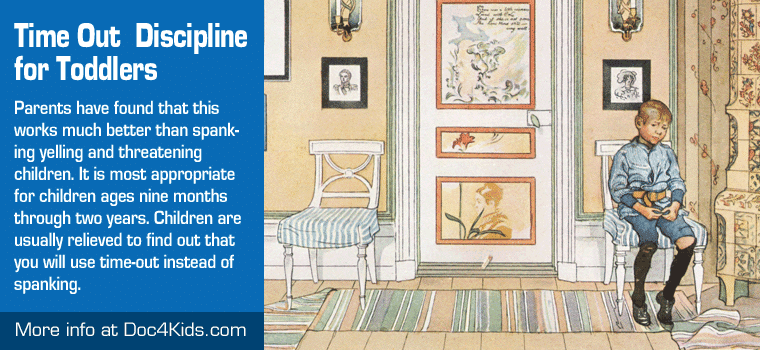Time Out – Discipline for Toddlers
Time-out basically involves your placing your child in his playpen for a short period of time following each occurrence of a negative behavior. This procedure has been effective in reducing problem behaviors such as tantrums, hitting, biting and other aggressive acts, failure to follow directions and jumping on furniture. Parents have found that this works much better than spanking yelling and threatening children. It is most appropriate for children ages nine months through two years. Children are usually relieved to find out that you will use time-out instead of spanking.
Preparations:
- A place for time-out should be selected. This could be your child’s playpen, chair or a hallway (not the child’s bedroom). It needs t be a dull place, but not a scary, dark or dangerous place. You need to find a boring place for them (find a place where they cannot see or hear the television).
- Discuss with your spouse which behaviors will result in time-out.
- Purchase a small kitchen timer.
- Let the child’s siblings know not to disturb the child when he is in time-out.
- Procedure:
- Following the negative behavior, say to the child, “No, don’t (bite, hit, etc).” Remain calm. There should be no screaming, talking angrily or nagging. Carry the child to the time-out area without talking to them. Carry him facing away from you. No one should talk to the child while he is in time-out. The child should not see anyone checking on him while in time-out.
- When the child is in the time-out area, wait until he has stopped crying for about 15 seconds. Once the child is quiet, set the kitchen timer for time-out (1-2 minutes/year of life). Let the child know that if the child makes noises or tries to leave the time-out area when in time-out, you will reset the timer to the beginning of the allotted time. During the time that the child is in time out, do NOT look at him, talk to him or pick him up. After he is finally quiet and through with time-out, go over to the time-out area and pick him up without saying a word. Set him on the floor near some of his toys. Do NOT reprimand him or mention what he did wrong.
- After each time in the time-out area, children should start with a “clean slate.” No discussion, nagging, threatening or reminding is necessary. At the first opportunity, look for and praise positive behavior–catch them being good.

